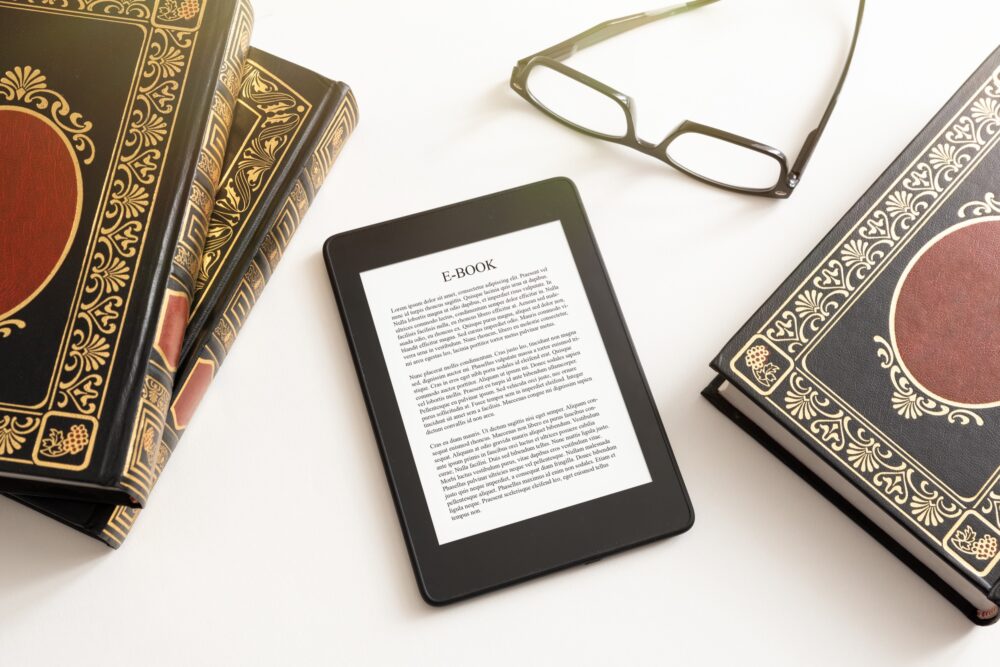
Years ago, during my first stint here at Saving Advice, I wrote an article about the value of an eReader. Was it a wise purchase or not? My conclusion at the time was that, no, it was not a wise purchase, at least for me. Of course, eReaders were in their infancy then, as were eBooks. Technology and publishing have changed. The world has changed. I’ve changed! So I thought it would be fun to revisit my old opinion and see what has changed, what has remained the same, and if my conclusion is still the same.
If you don’t want to read the individual reasons below, I’ll go ahead and tell you my overall conclusion. eReaders are absolutely worth it. I wasn’t a committed user until the Covid pandemic forced me to rely on my eReader as never before. Prior to the lockdowns, I had an eReader and used it. However, I didn’t use it every day or as my primary form of reading. Going to the library was still a source of fun and joy. When the physical libraries closed, the eReader became my lifeline. (Well, I could have ordered physical books from Amazon, but I read several books a week and the idea of paying for that many books traumatized my budget.)
Time went by. I became so accustomed to not having to drive to the library, to having instant access to a book the minute it entered my mind, and to the ability to take tons of books anywhere that I cannot go back. My eReader is now my best friend and you can have it when you pry it from my cold, dead hands.
But to get into more detail, here are the things that changed and those that stayed the same.
(Note that when I’m discussing eReaders here, I’m referring to eInk devices dedicated only to reading such as the Kindle or Kobo, not tablets like the iPad. They are very different devices and so the pros/cons would be completely different.)
Why I changed my mind:
Cheaper device price points
eReaders have, like all technology, dropped in price over the years. You can get a basic model for $50 – 100, depending on brand and sales. Basic models used to be easily over $200. The devices are more affordable and represent the cost of just a few physical books.
More device variety
Nowadays there’s something for everyone. There are small screens and large screens, pocket-sized to, “I need a sherpa to carry this.” You can find devices that are better at handling graphic novels/comics/illustrated reference books, or which allow you to make hand-written annotations on-screen. Some even handle audiobooks, if you enjoy both formats. You can find an eReader for you, even if your needs are specialized.
Library lending!
This is the biggest boon. Many libraries now serve up ebooks through Overdrive/Libby, Hoopla, or CloudLibrary. This means you can access plenty of free books, but without the hassle of going to the library to get and return books. Check out what your library offers and see if it meets your needs.
More books available
There are simply more eBooks available today than there were when I wrote my original opinion. Major publishers are fully on board, as are indie publishing houses and self-publishers. Publishers are even bringing older titles to the eBook market. There’s no shortage of choices.
More free/cheap books
In addition to library lending, there are now more free choices out there. Many publishers give the first of a series away for free as a promotional tool. Kindle Unlimited isn’t free, but it’s inexpensive and all-you-can-read once you’re a member. There are also lots of free classics at Project Gutenberg, and freebies from self- and indie publishers.
Helpful in downsizing
I’m getting older so the inevitable downsizing has begun. If there’s a book I simply must own, I can get the eBook and take up no space in my home.
Storage capacity has improved
An eReader can now hold thousands of books and accommodate the larger storage requirements of large PDFs, comics, and graphic novels. Years ago there wasn’t as much storage available, so specialized reference books or graphic novels were out. You could always carry a lot of books with you in your eReader, but now you can carry enough to last you for months on the road, if necessary. Overkill? Probably. But my back is happy that I’m not schlepping a bag of books on every trip.
Screens have improved
eInk has always been easier on the eyes than a phone or tablet screen, but the resolution these days is much sharper. You can also make more adjustments to the font sizes, font types, and lighting. Some models now come with lighting that adjusts with the daylight to further reduce eyestrain. This is great for my aging eyes.
Improved comfort
Devices are lighter and more ergonomic to hold. Most offer a shaped handhold or textured backing to make holding more secure. The lightness means you can hold them in almost any position for a long period of time without fatigue. Many are waterproof or water-resistant so you can read in the comfort of your bath or by the pool without fear. Some have page-turn buttons in addition to the more common swipe-to-turn functionality. And some allow you to flip the device horizontally or vertically as you prefer. All of this combines to make a device much more comfortable for individual preferences.
Third-party software and additional bookstores have largely solved the format problems
It used to be that a book came in whatever format you purchased it in and that was it. If you moved from a Kindle to another platform you were out of luck. Now, many of these problems have been solved (although not totally). Third-party software allows for format conversions. You do need a little techie know-how to use it, but not much. More bookstores mean you can find one that sells compatible books, no matter which device you use. Some publishers are even becoming platform agnostic and selling their books in open formats that any device can read.
Why you may not agree with me:
It still costs money
An eReader still costs money, even though it’s much less than it used to be. If you prefer to avoid that expense, then stick with free library books.
Also, even if you do pay for an eReader, it’s likely that there will be some ongoing expense over the years as, like any electronic device, you will need to upgrade or replace it when the battery fails or it breaks. Most eInk devices can go for years without breaking down, but eventually, you’ll need another one.
You love paper books
Some people will never give up paper books. The smell, the tactile feel… I get it. I used to be that way until the pandemic forced me to abandon real books for a while and now I’m over it. However, if that’s your preference then an eReader will be miserable for you.
You don’t have full control over the books and ecosystem
eBooks are still not like paper books. You can’t sell or trade the book when you’re done with it. (Even Kindle has done away with the ability to loan books to others.) Technically, a book can be removed from your account due to licensing/publishing issues, although it is rare. If the store you buy from goes out of business, you may lose access to your books. With eBooks, you don’t have the guaranteed control that you have over a physical book collection.
If you buy best-selling ebooks, they aren’t cheaper than print
While there are a lot of free/cheap books out there, you won’t find the big-name bestsellers among them (outside of something like a Black Friday sale). For reasons that are too long to get into here, some publishers still charge far too much for a non-physical book. Most bestselling eBooks are the same price as their print counterparts. If bestsellers from big houses make up the bulk of your purchasing, you won’t save money. At that point, you have to decide which experience you prefer.
So there you have it. My eReader is now among my favorite possessions. You may feel differently, of course, but the devices have improved so much that I no longer feel a need for paper books. The eReader has been the best purchase I’ve ever made, especially when it comes to a gadget.
You aren’t a big reader
An eReader is great for those of us who chain-read books. We can carry a ton of titles, switch between them at will, source books on a whim from libraries and stores, and read from sunup to sundown while holding a lightweight device that adjusts the lighting for us. If you’re not a big reader, you likely won’t find the value in a device. It’s just not worth it if you’re only going to use it a few times per year.
Do you have any thoughts on eReaders? Share in the comments below.
Read More:
- Is an eReader a Wise Purchase
- Ways to Get Cheap Books When Your Library is Dying
- eReaders and eBooks
- Write eBooks: Strange Ways to Make Money
- The Ultimate Guide to Choosing the Best Tablet for Reading Comics
Come back to what you love! Dollardig.com is the most reliable cashback site on the web. Just sign up, click, shop, and get full cash back!

Jennifer Derrick is a freelance writer, novelist and children’s book author. When she’s not writing Jennifer enjoys running marathons, playing tennis, boardgames and reading pretty much everything she can get her hands on. You can learn more about Jennifer at: https://jenniferderrick.com/.
Comments